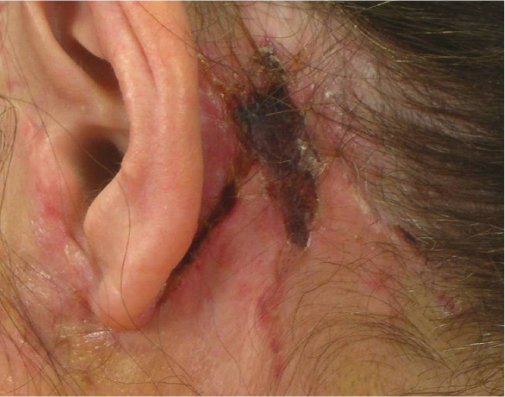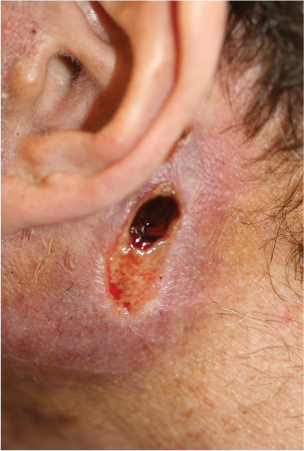11 Rejuvenation procedures of the aging face are increasing in frequency. Numerous techniques have been described since the first facelift was performed by Lexer in 1906.1 In 1968 Skoog performed the facelift procedure in a subfascial plane, improving the surgical results in the lower face.2 This led to Mitz and Peyronie’s contribution in 1976, defining the superficial fascia enveloping the face.3 They termed this fascia the superficial musculoaponeurotic system (SMAS). Identifying and defining the SMAS layer has led to a better understanding of facial anatomy and has spurred a variety of surgical facelift techniques. The facelift procedure remains the gold standard for surgical rejuvenation of the midface and lower face. Although numerous technical variations of the facelift have been described, the basic premise involves elevation of a facial skin flap with tightening of the underlying superficial fascia. After this is accomplished, the overlying excess skin is trimmed and reapproximated. When executed correctly, the rhytidectomy (facelift) procedure provides significant improvement in the appearance of the lower two-thirds of the face. This chapter identifies the common complications associated with this procedure and describes ways to prevent and treat these complications. The discussion covers prevention and management of preoperative, intraoperative, and postoperative problems. To prevent complications such as bleeding and skin necrosis, the surgeon must perform a careful preoperative work-up. This includes obtaining a detailed medical history and performing a thorough physical examination. The history should include the identification of all medical conditions that can cause poor wound healing, such as tobacco use, hypertension, peripheral artery disease, diabetes mellitus, and prior radiation therapy. The history should also identify any medications that can cause perioperative bleeding or delayed wound healing. Informed consent must be obtained before any medical intervention or surgical procedure. The informed choice process is even more important in elective cosmetic surgery, such as rhytidectomy. This process is defined as a two-way communication between the practitioner and patient, during which the goals of therapy are discussed, along with all therapeutic options, their associated risks, and potential complications. Informed consent involves full disclosure and must be presented in a clear and understandable manner. Adequate informed consent in cosmetic surgery requires both the patient and surgeon to have good communication skills. The surgeon must thoroughly explain the procedure, the attendant risks, the incisions, preoperative and postoperative care, and expected healing times. The surgeon should assess the patient’s ability to withstand the aesthetic surgery, both physically and psychologically. The patient should be able to process this information, ask questions, and avoid the temptation to have preconceived ideas and expectations related to the surgical procedures. Informed consent fails when there is a lack of communication. This occurs when the surgeon does not take the time or have the skills to explain the procedure adequately. Informed consent is also unsuccessful when the patient has preconceived ideas about surgery and unrealistic expectations relating to the cosmetic outcome. Poor communication between practitioners and patients is more likely if the patient has underlying psychological issues, such as anxiety, depression, body dysmorphic disorder (BDD), or significant problems with self-image.4 Inadequately performed informed consent in cosmetic surgery is common. Poor communication can lead to anger, frustration, and litigation; for these reasons, the number of malpractice suits filed against cosmetic surgeons is relatively high in relation to other specialties.5 Many systemic medicines, both prescribed and over-the-counter, can increase the risk of intraoperative and postoperative bleeding. The list includes well-known anticoagulants such as oral warfarin, platelet function inhibitors such as aspirin, and nonsteroidal anti-inflammatory medications. Other less commonly recognized oral remedies that can increase the risk of perioperative bleeding include vitamins such as vitamin E, herbal supplements such as Gingko biloba, fish oil, and antioxidants (Table 11.1).6 It is important to provide patients with a thorough list of medicines and supplements to avoid. A comprehensive medical history should be obtained from the patient. This is often facilitated by providing a detailed questionnaire before the initial consultation. All preoperative medical conditions and prior surgeries should be known and discussed. In particular, any conditions that may impact flap vascularity or postoperative healing should be identified. Some medical conditions, such as hypertension, may increase the risk of postoperative bleeding. For this reason, medical conditions should be evaluated and treated preoperatively to minimize postoperative risks. Certain medical conditions predispose the aesthetic surgery patient to postoperative complications. These include cardiac disease, peripheral vascular disease, and associated hypertension. Pulmonary disease, such as emphysema or chronic obstructive pulmonary disease, can increase the incidence of diminished flap vascularity and associated flap necrosis. In addition, patients with pulmonary diseases have a greater chance of postoperative coughing and straining, which can increase the risk of postoperative hematoma. Although it is very uncommon to experience impairment in facelift flap vascularity or even frank necrosis of facelift flaps, some medical conditions can predispose patients to these complications. Diabetes mellitus increases the risk of postoperative bruising, delayed healing, and infection. Although perioperative control of serum glucose should be obtained, patients with diabetes mellitus continue to have small-vessel peripheral artery disease, which may compromise vascular supply to the skin flaps. Cigarette smoking also decreases vascularity to skin flaps and therefore increases the risk of wound-healing issues and flap necrosis.7 For this reason, many surgeons refuse to perform facelift surgery on active smokers. Smokers should be encouraged to cease cigarette use for four weeks before and at least two weeks after the facelift procedure. If facelifts are performed on active smokers or on patients with diabetes mellitus, flap length should be decreased to minimize the potential for flap compromise. Table 11.1 Medicines to Avoid Prior to Rhytidectomy (Not Comprehensive)
Facelift Complications
 Preoperative Considerations
Preoperative Considerations
Informed Consent
Medical Conditions
Aspirin/NSAID products | Aleve, aspirin, BC powder, Bufferin, Diclofenac, Excedrin, Florinal, Goody’s headache powder, ibuprofen, ketolarac, Midol, Motrin, Naprosyn, Norgesic, salicylic acid, Soma, Toradol |
Herbal/natural products | Ginger, Gingko biloba, garlic, ginseng, echinacea, fish oils (omega-3 fatty acids), dong quai, feverfew, licorice root, pine bark extract, St. John’s wort, yohimbine |
Vitamins | Vitamin E |
Anticoagulants | Heparin, warfarin |
 Hematoma
Hematoma
Subcutaneous hematoma is one of the most common complications of facelift surgery. The incidence ranges from 2 to 15% of cases, depending on the published reports.7,8 The occurrence of a hematoma requires urgent treatment, and even if the hematoma is successfully evacuated, the sequelae may be long lasting.
The prevention of facelift hematoma should be the surgeon’s highest priority. This demands that the surgeon take a careful preoperative history and as much as possible eliminate or reduce known risk factors. For example, all rhytidectomy patients should discontinue medications containing aspirin for at least two weeks before surgery. Many patients are not aware that common over-the-counter preparations contain aspirin. Patients should be asked to read the labels of all medications in the two weeks prior to surgery. If patients are on anticoagulants such as warfarin sodium, the surgeon should consult with their primary physician to determine if it is safe to discontinue anticoagulation for elective aesthetic surgery. Other risk factors include the chronic use of nonsteroidal anti-inflammatory medications, platelet inhibitors, and high doses of vitamin E.
Tobacco smoking has been linked to an increased risk of complications in facelift surgery, including hematoma. All smokers must be required to stop smoking for at least four weeks before surgery. Some patients will not be fully truthful in reporting their progress in smoking cessation, but the tobacco smell can be easily detected in the preoperative area. The surgeon must be willing to cancel surgery in this situation. Smokers also have a much higher incidence of flap necrosis.
Hypertension is also a significant risk factor. Labile blood pressure in the postoperative period may predispose a patient to bleeding and hematoma.9 Preoperative screening should be performed to identify uncontrolled hypertension. Patients should be encouraged to continue their antihypertensive medication throughout the preoperative period. If hypertension is not well controlled, patients should be referred to their primary care physicians to adjust their antihypertensive medication. Meticulous surgical technique with care to dissect in proper tissue planes, combined with careful hemostasis, is essential for successful rhytidectomy surgery.
Fig. 11.1 Postauricular skin flap necrosis.
Fig. 11.2 Posterolateral neck skin flap necrosis.
Stay updated, free articles. Join our Telegram channel

Full access? Get Clinical Tree





